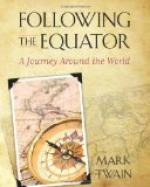But the explanation was simple. Years ago the fabulously rich silver discovery at Broken Hill burst suddenly upon an unexpectant world. Its stocks started at shillings, and went by leaps and bounds to the most fanciful figures. It was one of those cases where the cook puts a month’s wages into shares, and comes next mouth and buys your house at your own price, and moves into it herself; where the coachman takes a few shares, and next month sets up a bank; and where the common sailor invests the price of a spree, and next month buys out the steamship company and goes into business on his own hook. In a word, it was one of those excitements which bring multitudes of people to a common center with a rush, and whose needs must be supplied, and at once. Adelaide was close by, Sydney was far away. Adelaide threw a short railway across the border before Sydney had time to arrange for a long one; it was not worth while for Sydney to arrange at all. The whole vast trade-profit of Broken Hill fell into Adelaide’s hands, irrevocably. New South Wales furnishes for Broken Hill and sends her Judges 2,000 miles—mainly through alien countries—to administer it, but Adelaide takes the dividends and makes no moan.
We started at 4.20 in the afternoon, and moved across level until night. In the morning we had a stretch of “scrub” country—the kind of thing which is so useful to the Australian novelist. In the scrub the hostile aboriginal lurks, and flits mysteriously about, slipping out from time to time to surprise and slaughter the settler; then slipping back again, and leaving no track that the white man can follow. In the scrub the novelist’s heroine gets lost, search fails of result; she wanders here and there, and finally sinks down exhausted and unconscious, and the searchers pass within a yard or two of her, not suspecting that she is near, and by and by some rambler finds her bones and the pathetic diary which she had scribbled with her failing hand and left behind. Nobody can find a lost heroine in the scrub but the aboriginal “tracker,” and he will not lend himself to the scheme if it will interfere with the novelist’s plot. The scrub stretches miles and miles in all directions, and looks like a level roof of bush-tops without a break or a crack in it —as seamless as a blanket, to all appearance. One might as well walk under water and hope to guess out a route and stick to it, I should think. Yet it is claimed that the aboriginal “tracker” was able to hunt out people lost in the scrub. Also in the “bush”; also in the desert; and even follow them over patches of bare rocks and over alluvial ground which had to all appearance been washed clear of footprints.
From reading Australian books and talking with the people, I became convinced that the aboriginal tracker’s performances evince a craft, a penetration, a luminous sagacity, and a minuteness and accuracy of observation in the matter of detective-work not found in nearly so remarkable a degree in any other people, white or colored. In an official account of the blacks of Australia published by the government of Victoria, one reads that the aboriginal not only notices the faint marks left on the bark of a tree by the claws of a climbing opossum, but knows in some way or other whether the marks were made to-day or yesterday.




